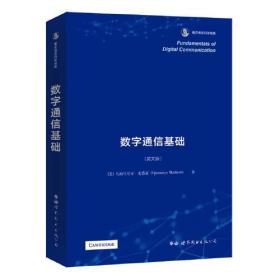
数字通信基础(英文版)
全新正版 极速发货
¥ 99.24 7.2折 ¥ 138 全新
库存2件
广东广州
认证卖家担保交易快速发货售后保障
作者(美)乌帕马尼亚·麦德豪|责编:陈亮//夏丹
出版社世界图书出版公司
ISBN9787519212452
出版时间2020-07
装帧平装
开本其他
定价138元
货号30940063
上书时间2024-06-29
- 最新上架
商品详情
- 品相描述:全新
- 商品描述
-
作者简介
乌帕马尼亚·麦德豪(Upamanyu Madhow)是美国加州大学圣芭芭拉分校电子与计算机工程系的教授。他是三家无线通信初创公司的共同创始人,并持有14项美国。麦德豪教授是靠前电气电子工程师学会的杰出会士(IEEE Fellow),担任过IEEE Transactions on Information Theory,IEEE Transactions on Communications,IEEE Transactions on Information Forensics and Security等多家非常不错期刊的副主编。麦德豪教授还获得过IEEE无线通信很好论文奖(IEEE Marconi Prize Paper Award in Wireless Communications),并入选ISI优选计算机领域高引用科学家名单(ISI Highly Cited Researcher)。
目录
Preface
Acknowledgements
1 Introduction
1.1 Components of a digital communication system
1.2 Text outline
1.3 Further reading
2 Modulation
2.1 Preliminaries
2.2 Complex baseband representation
2.3 Spectral description of random processes
2.3.1 Complex envelope for passband random processes
2.4 Modulation degrees of freedom
2.5 Linear modulation
2.5.1 Examples of linear modulation
2.5.2 Spectral occupancy of linearly modulated signals
2.5.3 The Nyquist criterion: relating bandwidth to symbol rate
2.5.4 Linear modulation as a building block
2.6 Orthogonal and biorthogonal modulation
2.7 Differential modulation
2.8 Further reading
2.9 Problems
2.9.1 Signals and systems
2.9.2 Complex baseband representation
2.9.3 Random processes
2.9.4 Modulation
3 Demodulation
3.1 Gaussian basics
3.2 Hypothesis testing basics
3.3 Signal space concepts
3.4 Optimal reception in AWGN
3.4.1 Geometry of the ML decision rule
3.4.2 Soft decisions
3.5 Performance analysis of ML reception
3.5.1 Performance with binary signaling
3.5.2 Performance with M-ary signaling
3.6 Bit-level demodulation
3.6.1 Bit-level soft decisions
3.7 Elements of link budget analysis
3.8 Further reading
3.9 Problems
3.9.1 Gaussian basics
3.9.2 Hypothesis testing basics
3.9.3 Receiver design and performance analysis for the AWGN channel
3.9.4 Link budget analysis
3.9.5 Some mathematical derivations
4 Synchronization and noncoherent communication
4.1 Receiver design requirements
4.2 Parameter estimation basics
4.2.1 Likelihood function of a signal in AWGN
4.3 Parameter estimation for synchronization
4.4 Noncoherent communication
4.4.1 Composite hypothesis testing
4.4.2 Optimal noncoherent demodulation
4.4.3 Differential modulation and demodulation
4.5 Performance of noncoherent communieation
4.5 .]Proper complex Gaussianity
4.5.2 Performance of binary noncoherent communication
4.5.3 Performance of M-ary noncoherent orthogonal signaling
4.5.4 Performance of DPSK
4.5.5 Block noncoherent demoxdulation
4.6 Further reading
4.7 Problems
5 Channel equalization
5.1 The channel model
5.2 Receiver front end
5.3 Eye diagrams
5.4 Maximum likelihood sequence estimation
5.4.1 Alternative MLSE formulation
5.5 Geometric model for suboptimal equalizer design
5.6 Linear equalization
5.6.1 Adaptive implementations
5.6.2 Performance analysis
5.7 Decision feedback equalization
5.7.1 Performance analysis
5.8 Performance analysis of MLSE
5.8.1 Union bound
5.8.2 Transfer function bound
5.9 Numerical comparison of equalization techniques
5.10 Further reading
5.11 Problems
5.11.1 MLSE
6 Information-theoretic limits and their computation
6.1 Capacity of AWGN channel: modeling and geometry
6.1.1 From continuous to discrete time
6.1.2 Capacity of the discrete-time AWGN channel
6.1.3 From discrete to continuous time
6.1.4 Summarizing the discrete-time AWGN model
6.2 Shannon theory basics
6.2.1 Entropy, mutual information, and divergence
6.2.2 The channel coding theorem
6.3 Some capacity computations
6.3.1 Capacity for standard constellations
6.3.2 Parallel Gaussian channels and waterfilling
6.4 Optimizing the input distribution
6.4.1 Convex optimization
6.4.2 Characterizing optimal input distributions
6.4.3 Computing optimal input distributions
6.5 Further reading
6.6 Problems
7 Channel coding
7.1 Binary convolutional codes
7.1.1 Nonrecursive nonsystematic encoding
7.1.2 Recursive systematic encoding
7.1.3 Maximum likelihood decoding
7.1.4 Performance analysis of ML decoding
7.1.5 Performance analysis for quantized o
内容摘要
本书是一本讲投数字通信系统设计基础概念与原理的简明教程。书中有大量从简单到最前沿的实例未展示理论是加何指导实践的。读者可以用计算和模拟来实现书中的算法,由此来理解其背后的理论。本书包含5G通信所使用的Turbo码和LDPC码等前沿内容,读者可以自己编程去实现性能评估与比较。本书还包括空时通信技术和对非相干通信和均衡的几何解释等特色内容。本书既可作为通信夹专业高年级本科生和研究生教材,又可供工程技术人员参考。
相关推荐
— 没有更多了 —





















以下为对购买帮助不大的评价